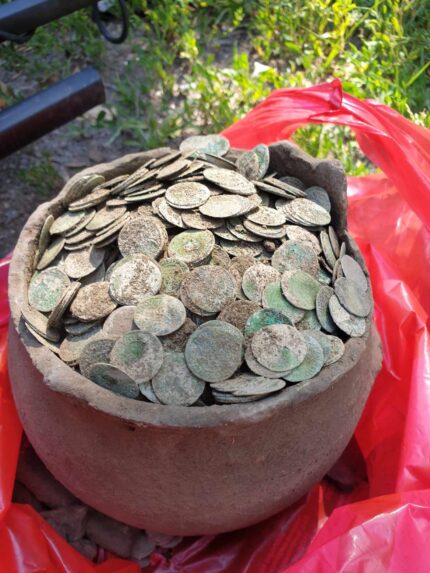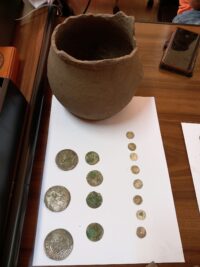 A group of metal detectorists scanning a forest near Neuorid, western Romania, have discovered a massive hoard of early 16th century coins buried in a ceramic vessel. Raul Vlad Suta was wielding the detector that first signalled the presence of the treasure. He dug into the topsoil and found a small silver coin, followed by another two. The rest of the group pitched in and after unearthing a few more coins at a shallow depth, they encountered the mouth of the vessel. They dug around it until it could be removed.
A group of metal detectorists scanning a forest near Neuorid, western Romania, have discovered a massive hoard of early 16th century coins buried in a ceramic vessel. Raul Vlad Suta was wielding the detector that first signalled the presence of the treasure. He dug into the topsoil and found a small silver coin, followed by another two. The rest of the group pitched in and after unearthing a few more coins at a shallow depth, they encountered the mouth of the vessel. They dug around it until it could be removed.
Romanian law requires metal detectorists to inform local municipal authorities or a museum of any find within 72 hours. The group handed the hoard over to the office of the mayor of Neuorid, and then worked with the city council to remove and identify the coins.

 They counted approximately 4,868 coins (some have become stuck to each other by corrosion materials, making them difficult to count) of the Hungarian dinar type struck during the reign of Vladislaus II, King of Bohemia (1471-1516), Hungary and Croatia (1490-1516). There are also three large silver thalers, each weighing 30 grams, and four coins of medium diameter that have not yet been identified. In total, the pot and coins weigh 4.5 kilos (10 lbs). The coins alone weigh about three kilos (6.6 lbs).
They counted approximately 4,868 coins (some have become stuck to each other by corrosion materials, making them difficult to count) of the Hungarian dinar type struck during the reign of Vladislaus II, King of Bohemia (1471-1516), Hungary and Croatia (1490-1516). There are also three large silver thalers, each weighing 30 grams, and four coins of medium diameter that have not yet been identified. In total, the pot and coins weigh 4.5 kilos (10 lbs). The coins alone weigh about three kilos (6.6 lbs).
The hoard is property of the state according to Romanian treasure laws and is destined for a museum, but the metal detectorists who found it are entitled to a reward amounting to 30%-45% of the market value of the hoard as determined by an official valuation.